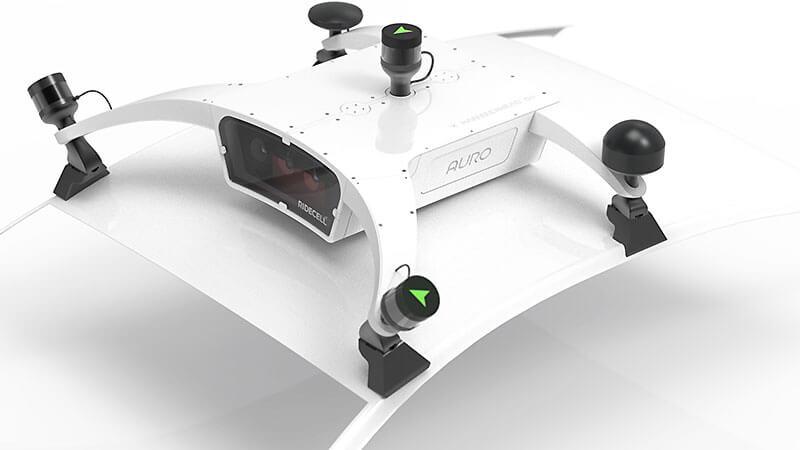
As the mobility and autonomous vehicle industry transition from a period of hyper-growth to a more consolidated phase, it is more important than ever to focus on near-term, real-world applications of L4 autonomy.
We, at Auro, the Autonomous Driving Division of Ridecell, are focusing our efforts on low-speed L4 empty vehicle automation for high-yield shared fleets. This niche use-case focuses on moving the vehicles autonomously to solve problems such as demand-based vehicle repositioning, refueling/charging/cleaning, maintenance, and doorstep (last-mile) delivery. Hammerhead, our patent-pending vehicle-agnostic autonomous sensor unit, takes us one step closer in achieving this vision of adding autonomy to the various shared fleets we operate across the globe.
The current blog introduces Hammerhead – the sensor housing unit developed for our autonomous test vehicle fleets.
Design Philosophy Behind Hammerhead
Building a hardware platform to package the sensors, computing, and power on a vehicle is one of the first bottlenecks faced by Autonomous Vehicle architects before being able to test their software stack in the real world.
The approach we take towards building the hardware unit ends up having implications on the calibration process, assembly and serviceability throughout the testing and development lifetime of that vehicle version.
We focused on three major design requirements while developing Hammerhead:
- Serviceability without affecting the sensor calibration: Keep the hardware unit modular/serviceable i.e. make it easy to service/replace/repair the internal components like computing units, GPS, IMU systems or antenna while retaining the calibration of Lidars and cameras.
- Customizable with new sensor models: Make it easy to customize the platform with new sensor units. This helps us to test the new models of LiDars, cameras, INS, computing units that come out frequently in the market, without making major design changes to the hardware.
- Scalable to different vehicle models: As a company that is aiming to add autonomy to the various shared fleets we operate in multiple cities, where we want to build a hardware unit that is easy to deploy and test on different types of vehicle models – be it a Toyota Prius or Volkswagen E-Golf or a BMW I-Drive.
The following sections walk through the design and installation processes, and the core features of our Hammerhead sensor housing unit meeting the above design requirements
Overview of the Design Process

Inspired by the sleek lines and form of the hammerhead shark, after which the system is named, the unit follows the outline of the car to minimize drag and reduce wind noise while ensuring a clear field of view for each of the sensors.
The Hammerhead is able to withstand even the harshest of conditions with a gasketed waterproof aluminum housing, an efficient air-cooling system, and a “gear tray” electronic shock-isolation mount.

To iterate, optimize, and validate the design before investing in part manufacturing, we performed software-based simulation for CFD (airflow), vibration/modal, stress, and thermal analysis.

Modal Analysis

Stress Analysis
CFD Analysis
Component Surface Temp Thermal Analysis
Installation Process
The Hammerhead unit houses multiple LiDARs, cameras, antennas, and sensor/processing electronics which form the essential components of our L4 autonomous driving system.
We employ the following steps on a high level to assemble Hammerhead on any new vehicle platform.
The main “body” enclosure and “arms” are assembled on the bench to strict quality and fit requirements. The electronics and cabling are installed into a modular “gear tray” and tested for electrical and system-level functionality requirements. Next, the two subsystems (body and gear tray) are mated together along with the external sensors.
The completed Hammerhead assembly is then installed onto the roof of the vehicle by adjusting the modular “arms” and adaptable vehicle specific clasps, attaching it securely to the sides of the vehicle, and torquing down the locking bolts. Finally, the Hammerhead umbilical cable harness is connected to the rooftop cable pass-through gland that interfaces with the rest of the vehicle.
Once the Hammerhead hardware installation is complete, we move onto the steps of software installation, sensor calibration, and functional testing.
Modularity for Effortless Customization and Serviceability

Modular Components of Hammerhead
Designed for flexibility, most parts and electronics are designed to be easily accessible, separable, and replaceable. Accessing the internal components is as easy as unbolting four top covers with gasketed seals. The entire internal “gear tray” and attached electronic components can then easily be removed, replaced, swapped, reconfigured, modified, and/or re-installed without impacting sensor calibration.
The sensor mounts on each of the modular arms and centerline are also adjustable and completely customizable, giving us the ability to add or swap out external sensors and add cameras or replace them as needed. The Lidar mounts are also adjustable to +/- 15 degrees allowing us to tune the pitch and angle of each sensor.

Adjustable Lidar Mount

Antenna Mount
There is also the option to customize a vehicle’s name or company’s logo, add in external communication screens, or additional sensors to the side panels of the unit body as required.
Top Cover

Side Cover
Agnostic to the base vehicle model
The Hammerhead system is designed to be a stand-alone unit and be easily retrofitted to existing fleet vehicles. Not only is the installation easier, but also no major permanent modifications are necessary for the base vehicle platform. The entire Hammerhead system can be disconnected and removed from the vehicle and be transferred to another car without having to alter any sensors or electronic components. This simple swap allows for efficient comparison (and testing) across a number of different vehicles, as more variety of autonomous vehicles get added to the fleet.
Our aim is to add autonomy to the various shared fleets being operated by Ridecell’s platform across the world. The Hammerhead system is engineered to give us an edge in that direction.
Stay tuned for more updates from Ridecell-Auro – the autonomous driving division from Ridecell.
Author: Richard Ho, Lead Hardware Engineer, Auro, Autonomous Driving Division of Ridecell





